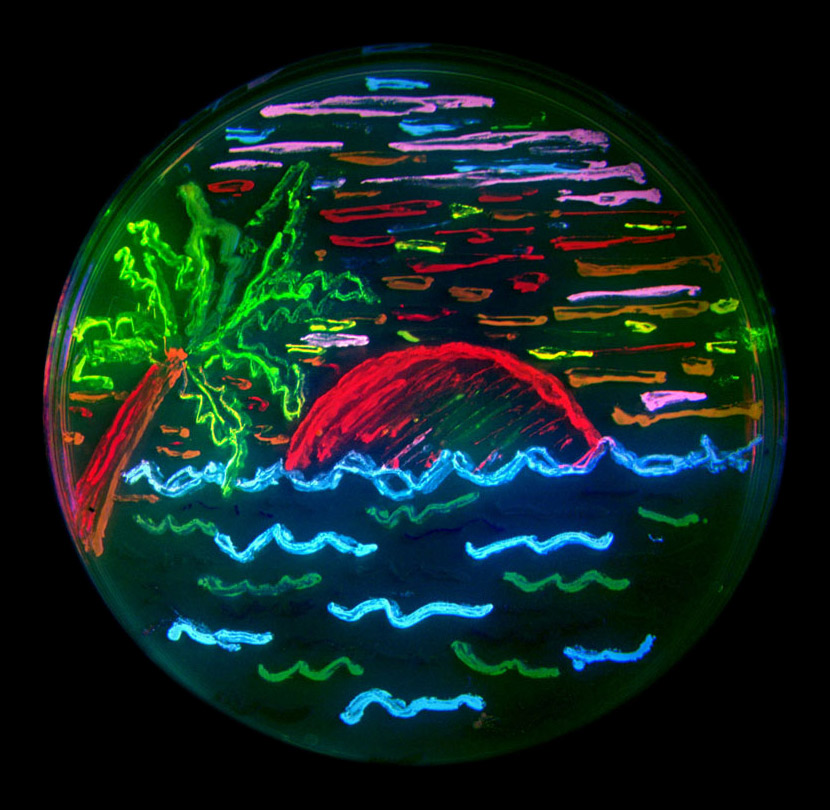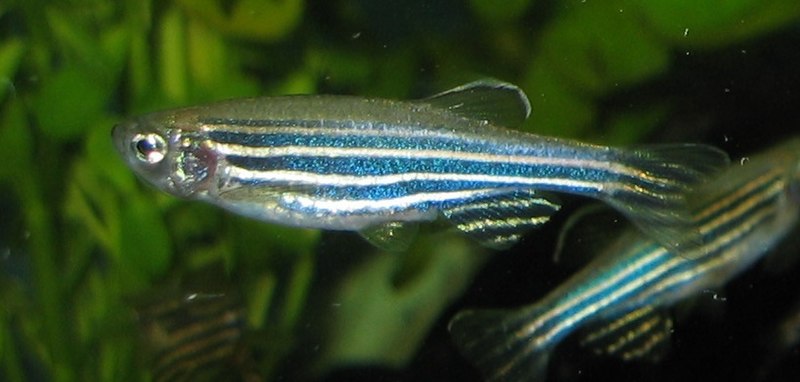
I am not a structual biologist and often find myself getting a bit bored at the minutiae of structural details that excite biochemists at lunchtime seminars but I must admit that I find the structure of GFP to be a thing of geeky beauty. GFP has what is known as a beta barrel or "can", which is comprised of a number of beta strands (a particular arrangement of protein strands that make a kind of sheet) wrapped into a tube (or barrel). Within this barrel, sits some modified amino acid residues called the "chromophore", which are responsible for the fluorescent aspect of GFP. This is then protected by caps at the top and bottom of the barrel.
I don't feel too bad about liking this - Julian Voss-Andreae liked it enough to make a sculpture!

GFP works by absorbing light of one wavelength and emitting light of another. In the case of the original GFP from jellyfish, UV or blue light is absorbed and green light is emitted, hence GFP. (The blue light itself is generated by another protein (aequorin), which is "chemiluminescent" and emits light in response to a chemical stimulus - in this case, a release of calcium in response to external stimulation. GFP and aequorin were first isolated from "squeezate", which is what you get when you pass jellyfish through some gauze!)
 Other colours also exist, both in nature and as a result of tinkering by various scientists over the years. As well as enabling some fun "lab art", such as this "San Diego beach scene" created in the lab of Nobelist Roger Tsien [Artwork by Nathan Shaner, photography by Paul Steinbach] made using eight different fluorescent proteins, including a Red Fluorescent Protein (RFP) from corals that I have done a bit of work on. (I'll save that for another time.) I love the names of some of the colours too: "BFP, mTFP1, Emerald, Citrine, mOrange, mApple, mCherry and mGrape". (Mmmmmm.... Cherry.)
Other colours also exist, both in nature and as a result of tinkering by various scientists over the years. As well as enabling some fun "lab art", such as this "San Diego beach scene" created in the lab of Nobelist Roger Tsien [Artwork by Nathan Shaner, photography by Paul Steinbach] made using eight different fluorescent proteins, including a Red Fluorescent Protein (RFP) from corals that I have done a bit of work on. (I'll save that for another time.) I love the names of some of the colours too: "BFP, mTFP1, Emerald, Citrine, mOrange, mApple, mCherry and mGrape". (Mmmmmm.... Cherry.)This diversity has led to some amazing research tools that have in turn led to some amazing discoveries, hence the Nobel prize. There are far too many to list here but one such technique that I make indirect use of in my own work is "FRET": "Fluorescent (or Förster) Resonance Energy Transfer", which is used for (among other things) detecting likely protein-protein interactions. It works a bit like the original GFP in jellyfish, using the emission of light from one protein to trigger fluorescence in the other. Unlike the jellyfish, however, FRET uses a GFP-like protein for each step. Each FP is attached to a different protein of interest and light is provided that excites the first protein. If the two proteins get close enough, such as if they interact, the emission from the first protein excites the second protein and the emission spectrum shifts, allowing the interaction (or, more accurately, proximity) to be detected.
Perhaps more fun are some of the recreational uses of the GFP family of proteins, such as these "GloFish", which demonstrate the power of genetically modification in a fun and friendly way. (Take that, Pope!)

 These guys are zebrafish (shown to the right in their normal colours) that have been genetically modified to express different FPs, causing them to fluoresce under different light. (White light works but blue light is best, I think.) You can see videos of them swimming about here. The original goal was to create fish that could be used for detecting environmental pollution etc. but, given restrictions on releasing GM animals into the wild, I think that fun fluorescing pets is probaby a more practical (and lucrative) application! Other GFP'd animals (usually for scientific reasons) include mice, monkeys, cats, pigs and, of course, Alba the GFP albino rabbit, although I am always a little wary of colour enhancement for images of such things. I'd still like to have one as a pet, though!
These guys are zebrafish (shown to the right in their normal colours) that have been genetically modified to express different FPs, causing them to fluoresce under different light. (White light works but blue light is best, I think.) You can see videos of them swimming about here. The original goal was to create fish that could be used for detecting environmental pollution etc. but, given restrictions on releasing GM animals into the wild, I think that fun fluorescing pets is probaby a more practical (and lucrative) application! Other GFP'd animals (usually for scientific reasons) include mice, monkeys, cats, pigs and, of course, Alba the GFP albino rabbit, although I am always a little wary of colour enhancement for images of such things. I'd still like to have one as a pet, though!
No comments:
Post a Comment
Thanks for leaving a comment! (Unless you're a spammer, in which case please stop - I am only going to delete it. You are just wasting your time and mine.)